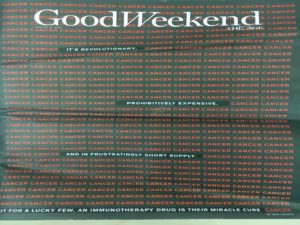“It´s revolutionary, prohibitively expensive, and in frustratingly short supply, but for a Lucky Few, an immunotherapy drug is their miracle CURE “ – This is how the August 20, 2016 GoodWeekend journal´s (1) cover looked like in Melbourne, Australia, exactly the week when the International Conference of Immunology (ICI) took place in the same city and gathered more than 4000 clinicians, scientist, students to discuss new research in immunology and very importantly for me, as a PhD Student in the field of cancer immunology (member of Immunosensation cluster of Bonn), the immunotherapy of cancer.

Cover of GoodWeekend journal’s edition from August 20th 2016
The roots of cancer immunotherapy – An accidental discovery
Many of you might be surprised, if I say immunotherapy started out in the walls of the University Clinic of Bonn. We can undoubtedly say the pioneer of the immunotherapy was Wilhelm Busch. It might be by accident, however, all great discoveries start with an accident. In 1868, W. Busch professor of surgery at the University Bonn accidently placed a severely sick sarcoma patient in the bed of a patient with erysipelas bacterial infection. Strikingly, the sarcoma patient’s tumor shrunk, but the patient, unfortunately died after 9 days from the infection (2). Thirty years later, in the United States, a very ambitious, intelligent American surgeon, Dr. William B. Coley, disappointed by a death of a young sarcoma patient, looked into the running literature and made a great discovery. Dr. Coley found other cases in which cancers went away after erysipelas. Dr. Coley started injection of terminally ill cancer patients with streptococcal bacteria in the 1890s and was widely considered the father of cancer immunotherapy. His first patient, with advanced sarcoma, went in to a remission and lived eight years. Even in early times, good news spread quickly. The Russian physician and play writer Anton Chekhov wrote in his letter to a colleague in 1890: “It has long been noted that the growth of malignant tumors halts for a time when this disease (erysipelas) is present” (3). However, people have turned away from Coley´s Toxin many times, opting for new, and more promising and fashionable treatments, to radiation therapy in early 20th or to Chemotherapy after the World War II.
Cancer immunotherapy today – There is still a lot unknown
Not so long ago, immunotherapy came in the focus of the scientific community again, when James P. Allison discovered the benefits of checkpoint inhibitors for cancer immunotherapy. And today at the ICI2016 meeting, as mentioned in the blog article by Dr. Isis Ludwig-Portugall (Immune Checkpoint Blockade: A milestone on the way to cure cancer), a huge part was devoted to immunotherapy, so called immune checkpoint inhibitors in the treatment of various types of cancers.
There was a lot complicated stuff presented at the meeting. There is still a lot unknown about mechanisms of action of immune checkpoint inhibitors parts of which Dr. Isis Ludwig-Portugall already discussed in her article. However, there is still enough room for improvement. One beautiful example was a talk given by Nicolas Restifo, MD, on research conducted at the NIH. Moreover, during the conference days, their story went online in Cell (4). Dr. Restifo brought us back to, as he calls it, something more “basic”, such as Mendeleev’s periodic table. In the beginning of his talk, he prompted scientist to think of the most abundant element on earth and in the human body. What do you think?
A role of oxygen and potassium in suppressing immune cells
The Group of Restifo was wondering why the lung is one of the most common sites of metastasis; of note, 90 % of death of cancer patients is due to the metastatic spread. Paradoxically, Restifo´s group identified oxygen to be immunosuppressive in the lungs, surprising right? It appears that oxygen, by suppressing the immune system, protects from overreacting towards those harmless particles that frequently enter the lungs. However, unfortunately for patients with cancer, oxygen being immunosuppressive is used for the benefit of the tumor cells. The research team discovered that an oxygen–sensing protein, called Prolyl Hydroxylase Domain (PHD) protein, acts within T cells to prevent excessively strong immune responses. Inhibiting oxygen sensing either genetically or pharmacologically in T cells strongly impaired metastatic spread to the lungs. A very intelligent approach to understand the resistance mechanism to immunotherapy.

Author Meri Rogava in Australia (by M. Rogava)
The story of the elements in cancer immunotherapy continued with another representative of Mendeleev’s table – potassium (5). Restifo´s group studied the role of potassium in tumor pathogenesis. Normal cells maintain concentration gradient across membranes, with low concentration of potassium ions outside and high concentrations inside the cell. However, upon cell death potassium is released from inside to the surrounding. In the tumor microenvironment where tumor cell death takes place, high potassium levels seem to impair T cell effector function – another potential mechanism of resistance to immunotherapy. Importantly, researchers found a way to genetically manipulate tumor specific T cells. They make them fit for high levels of potassium and showed, that genetically modified “fit” T cells were now able to eliminate established tumors in mice. This brilliant approach keeps promise for human T cells in future clinical trials too.
We need to understand and realize, we are not there yet, only 10-30 % of patients respond to immunotherapy, and many are just refractory. However, this can change in the future, by a deeper understanding of the immune response to cancer, and multiple different approaches to understand how the immune system and cancer interact.
References:
- Fight Club: Immunotherapy bladder cancer treatment. Available at: http://www.smh.com.au/interactive/2016/fight-club/.
- Book: Biomedical Material and Diagnostic devices. Tiwari … 15.5 Bacteria –Mediated Cancer Therapy
- Grady, D. Harnessing the Immune System to Fight Cancer. The New York Times (2016).
- Clever, D. et al. Oxygen Sensing by T Cells Establishes an Immunologically Tolerant Metastatic Niche. Cell 166, 1117–1131.e14 (2016).
- Eil, R. et al. Ionic immune suppression within the tumour microenvironment limits T cell effector function. Nature 537, 539–543 (2016).
Author: Meri Rogava

Pingback: Fighting Melanoma – Quantum Leap Ahead - ImmunosensationBlog